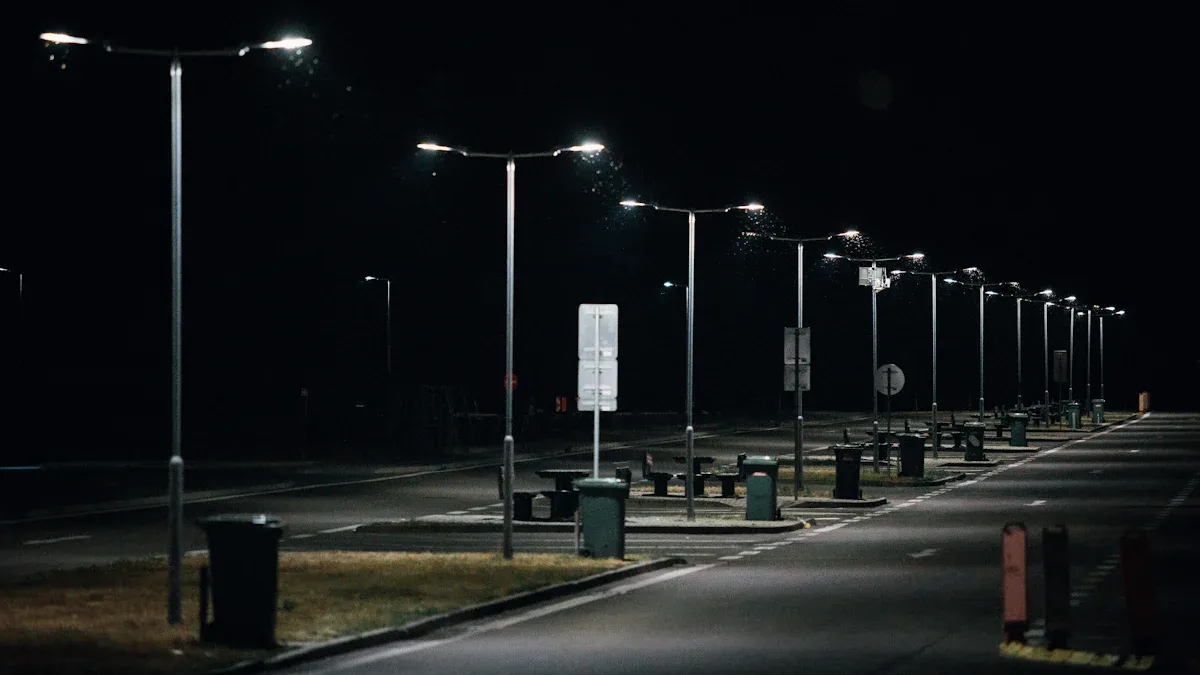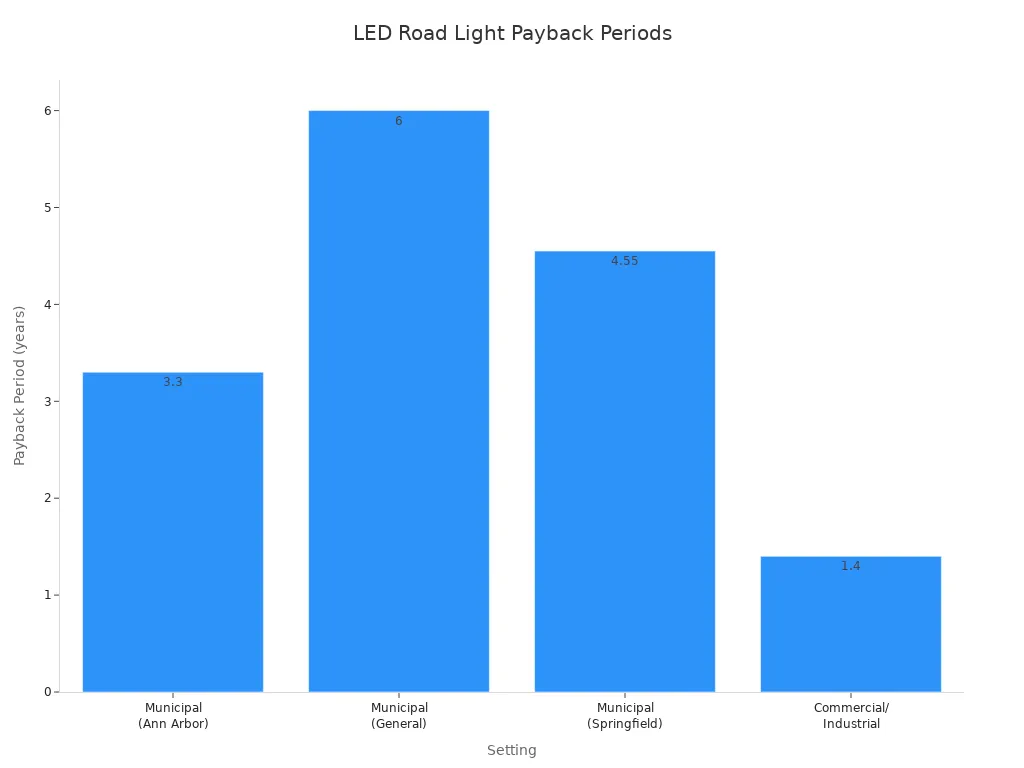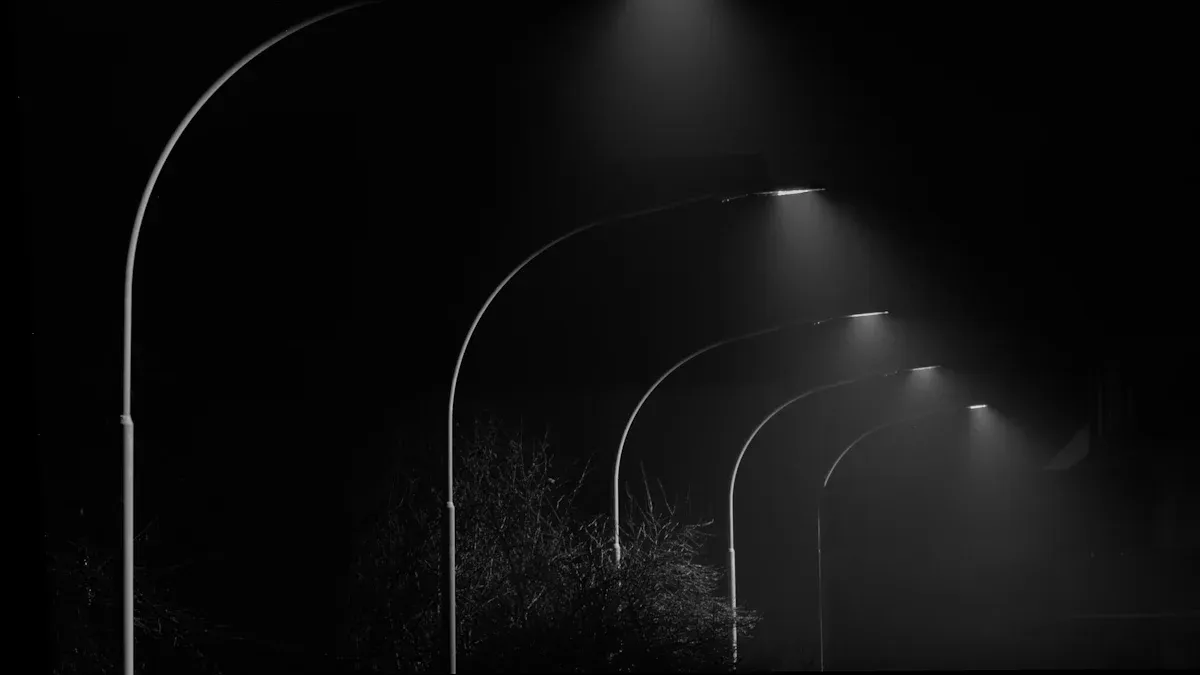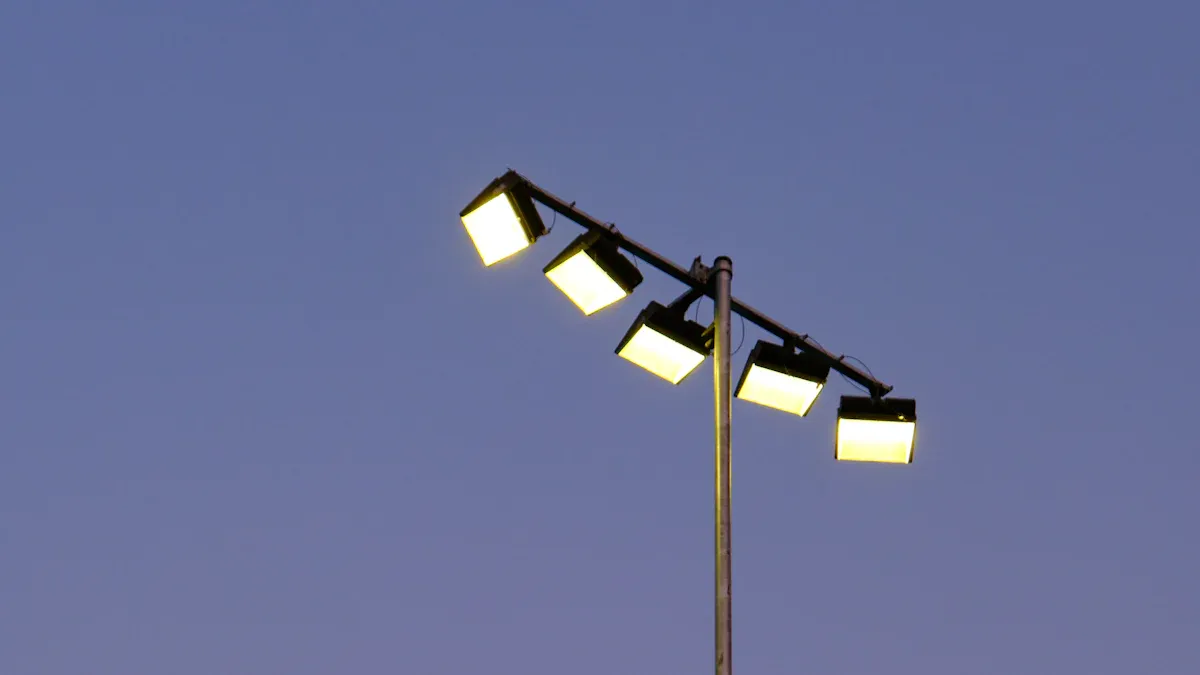Choosing the Best LED Road Lights for Municipal and Commercial Applications

City planners and facility managers must make an important choice when picking the best led road lights for their towns. Good street lighting keeps people safe, saves money on energy, and needs less fixing over time. Think about a city where bright LED streetlights help lower night crime by up to 36%. They also use up to 70% less energy.
Better lighting makes streets safer for people walking and driving.
Cities like Los Angeles save a lot of money each year after using LEDs.
Smart systems can change how bright the lights are, based on what is needed right then.
Choosing the best led road lights means looking at technical features, saving energy, and how long they last. People should pick products that give good value and work well, whether for city roads, business places, or even home upgrades. For more information, look at the About Us and Product sections or see the newest Led Light ideas.
Key Takeaways
LED road lights use less energy. They can save up to 70% on energy. They also lower maintenance costs by up to 90%. This makes them a smart and cheap choice for cities and businesses.
Good LED street lights give bright and even light. They have less glare. This helps drivers and people walking see better and stay safe.
Strong LED lights with an IP65 rating keep out dust and water. They can handle bad weather. This means they last a long time outside.
Smart LED lights have sensors and remote controls. These features help save energy. They also make it easy to check and fix the lights.
When picking LED lights, you need to check technical specs. You should look at certifications and warranties. It is important to buy from trusted suppliers. This helps you get good and reliable products.
Key Factors for the Best LED Road Lights
Energy Efficiency
Energy efficiency is very important when picking led road lights. New led street lights use much less energy than old bulbs. They use up to 90% less energy than incandescent bulbs. They also use about 75% less than other old lights. This helps cities and businesses save a lot of money. LEDs turn almost all energy into light. This means less waste and lower electric bills.
Lighting Type | Energy Consumption Compared to LEDs |
|---|---|
Incandescent Bulbs | LEDs use about 75% less electricity |
Fluorescent Lights | LEDs use around 50% less electricity |
Cities that use led street lights can save up to 70% on energy. These savings help pay for the higher cost at first. This makes LEDs a smart choice for the future. Dusk-to-dawn lights work only when it is dark. This saves even more energy.
Illumination Quality
Good lighting helps keep roads safe and comfortable. Led street lights give even light. This means there are fewer dark spots and less glare. Main roads should have a uniformity ratio of at least 0.4. This helps drivers see better and not get tired. The color rendering index should be above 70. This lets people see colors clearly and react fast.
Note: Good lighting helps drivers see people and things on the road. This makes roads safer for everyone.
The best led road lights are very bright. Top models give 150 to 180 lumens per watt. This means they are bright but still save energy. Dusk-to-dawn lights can change color temperature from 3000K to 5000K. This makes roads look nice and helps people see well.
Roadway Type | |
|---|---|
Interstate/Freeways | 6.5–12 |
Principal Arterials | 8.6–17 |
Minor Arterials | 7.5–15 |
Collectors | 6.5–12 |
Local | 8.6 |

Durability and IP65 Rating
Durability means led street lights can handle tough weather. An IP65 rating or higher is needed for outdoor lights. This rating keeps out dust and water jets. It helps lights work during rain, dust, and snow. If the IP rating is too low, water can get in and break the lights.
Aluminum and stainless steel housings stop rust.
Waterproof gaskets and sealants keep water out.
Heat sinks keep the inside cool and safe.
Anti-icing and strong mounts help in ice and wind.
Tip: Always check that the housing and inside parts have the right IP rating for your area.
Maintenance and Lifespan
The best led road lights last a long time and need little fixing. Good models last 50,000 to 100,000 hours. This is about 20 to 25 years of use. Old street lights like high-pressure sodium lamps last only about 24,000 hours.
Feature | LED Street Lights | Conventional HPS Street Lights |
|---|---|---|
Lifespan (hours) | 50,000–100,000 | ~24,000 |
Expected Lifespan (years) | 20–25 | ~12 |
Maintenance Interval | Longer | Shorter |
Heat Emission | Low | Higher |
Operational Cost | Lower | Higher |
LEDs need fewer changes and less work to fix. This can cut maintenance costs by up to 90% in ten years. Cities like Los Angeles save $150,000 each year for every 10,000 lights they switch to LED. Many lights have parts you can swap out easily. This saves even more money and time.
Smart Features
Many new led street lights have smart features. These make them work better and save more energy. Adaptive lighting uses sensors to change brightness as needed. Remote controls let managers check lights and fix problems from far away.
Motion sensors turn lights on only when needed.
IoT lets lights work with cameras and other smart tools.
Dimming and adaptive brightness save energy but keep roads safe.
Predictive tools find problems early and help fix them fast.
Smart features in dusk-to-dawn lights help save energy and fix problems quickly.
Cost-Effectiveness
Cost-effectiveness means thinking about price, savings, and value. Led street lights cost more at first than old lights. But they save money because they use less energy and last longer. Cities usually get their money back in 3 to 7 years. Businesses can see savings in just over a year.
Setting | Payback Period (years) |
|---|---|
Municipal (General) | 5–7 |
City of Springfield | |
Commercial/Industrial | 1.4 |

Led street lights cost less to run over time than old lights. They need less fixing, use less power, and last longer. This makes them the best choice for city and business street lighting.
Why High-Quality LED Street Lights Matter

Safety and Visibility
High-quality LED street lights help people see roads at night. Many city planners think brighter lights help drivers and walkers see better. Lighting companies say LED street lights can lower accidents and stop crime by making things easier to see. But a big study in the UK found something different. After cities put in more bright LED street lights, accident rates did not go down. Instead, road crashes went up by 11%. Accidents during dark hours rose by 16%. The researchers checked their work and looked at other reasons for the changes. Their results show that just making lights brighter does not always make roads safer. Cities should think about where they put lights and how good the lighting is, not just how bright it is.
Note: Good visibility helps people feel safe and find their way, but safety depends on more than just how bright the lights are.
Environmental Impact
LED street lights help cities use less energy and protect the planet. These lights use much less power than old ones like high-pressure sodium lamps. For example, New York City saved $14 million by changing over 250,000 street lights to LEDs. LED street lights do not have mercury and can be recycled. This means less dangerous waste. Studies show LED street lights use 6% to 75% less energy than old lamps. Using less energy means fewer greenhouse gases, especially in places that use fossil fuels for power. LEDs last longer, so cities do not need to replace them as often. This means less trash and less pollution. By picking LED street lights, cities help fight climate change and keep the air cleaner.
Operational Savings
Cities and businesses save a lot of money when they use high-quality LED street lights. They pay less for energy and do not need to fix the lights as often. Cities use special tools to figure out how much money they can save over time. Boulder, Colorado, saved about $1.1 million each year after switching to LEDs. They also cut their energy bills by 85%. On average, cities save 61% after changing to LEDs. Each light saves about $114 every year. Maintenance costs drop to only $22 per light each year. LED street lights also make it easier to add smart city features. These features help cities work better and can bring in more money.
Evidence Aspect | Details |
|---|---|
Cost Savings Percentage | Up to 80% cost savings reported by municipalities |
Average Cost Reduction | 61% average reduction in costs after LED upgrades |
City of Boulder Specific Savings | $1.1 million saved annually; 85% reduction in energy expenses |
Average Annual Maintenance Cost | $22 per light per year after LED conversion |
Average Cost Savings per Light | $114 saved per light per year |
Energy Savings | 110 million kWh saved annually across projects |
Operational Improvements | Faster maintenance response times, smart city technology integration |
Types of LED Street Lights

Cobra Head Fixtures
Cobra head fixtures are the most popular for city roads. Cities like Elgin use these led street lights on many streets. They put them on local, collector, and main roads. The city changes old lights to new GE Evolve LED cobra head models. This helps save energy and cuts down on fixing costs. The city picks different wattages and colors for each road. For example, 3000K lights are good for homes. 4000K lights work better on busy roads. Sendayan Tech Valley uses cobra head led street lights at roundabouts and main roads too. Brighter lights, like 135W, are used at intersections. These upgrades help lower accidents and make drivers more alert.
Area and Parking Lot Lights
Area and parking lot led street lights are used for open spaces. They give wide, even light to cover big areas. These lights have a wide beam, about 120-130° wide and 100-110° forward. This helps stop dark spots and makes places safer. Parking lot lights often use cooler colors to help people see better. You can put these lights on poles, walls, or the ground. The table below shows how street lights and parking lot lights are different:
Feature | LED Street Lights | LED Parking Lot (Area) Lights |
|---|---|---|
Light Distribution | Linear, focused beam angles (Type II, III, IV) | Broad, circular or widespread coverage (Type V or III) |
Mounting Height | 20 to 40 feet | 15 to 25 feet |
Design | Slim, elongated, cobra-head or rectangular shape | Broader, versatile mounting options |
Brightness & Wattage | 40W to 400W | 50W to 300W |
Color Temperature | Warmer tones (~3000K) | Cooler tones |
Purpose | Roadway illumination, traffic safety | Security and navigation in parking areas |
LED area lights are now the top choice for parking lots. They save energy, last a long time, and spread light evenly. A 300W LED can take the place of a 1000W metal halide. This saves power and means less fixing.
Adaptive and Specialty Lights
Adaptive and specialty led street lights meet special needs for cities and businesses. These lights use smart tech to change brightness when needed. They get dimmer when fewer people are around. This saves energy. LEDs in these systems turn on right away and can last up to 100,000 hours. They also show colors well, which helps people see better and stay safe. Smart tech lets people check the lights from far away and see how much energy is used. Some special lights use solar power or work from dusk to dawn. These choices use less energy and are better for the planet. They help cities build flexible lighting and cut down on pollution.
Tip: Adaptive led street lights can help stop too much light at night and keep city nature healthier.
How to Choose the Best LED Street Lights
Picking the best LED street lights for cities or businesses takes careful planning. You need to look at technical details, check for certifications, compare warranties, trust your supplier, and study the site. Each step helps make sure the lights are safe, save energy, and last a long time.
Assessing Technical Specs
City planners and managers should look at important technical features when picking LED street lights. These features help save energy, keep people safe, and lower repair needs.
Change old HID streetlights to LEDs to use less energy and fix less.
Pick fixtures that spread light well and do not cause glare.
Make sure the color rendering index is 70 or higher for clear sight.
Do not just swap bulbs; think about how LEDs spread light and their color.
Add networked controls for dimming, finding outages, and changing brightness.
Use shielded fixtures and special optics to stop glare and light pollution.
Pick strong, weatherproof materials and designs that are easy to fix.
Try lighting simulation tools like Dialux or Relux to plan your project.
Make sure the lights give at least 100 lumens per watt.
Choose color temperatures of 3000K to 4000K for cities, and 4000K to 5000K for highways.
Add smart controls like motion sensors to save energy and make lights more reliable.
Smart street lighting uses LEDs with remote controls and sensors. These systems can cut power bills by up to 60%. They also help cities reach safety and green goals. Sensors can check air quality, temperature, and parking spaces. This gives real-time data to help cities run better.
Tip: Always look at technical datasheets and ask for a side-by-side test of the best LED street lights before you choose.
Checking Certifications
Certifications show that LED street lights meet strict rules for safety, quality, and the environment. The table below lists the most important certifications and what they mean:
Certification / Standard | Purpose / Focus | Importance for LED Street Lights |
|---|---|---|
CE Mark (EN/IEC 60598 series, EN 62493, etc.) | EU safety, health, and environmental regulations | Mandatory in Europe; ensures safety and environmental impact |
UL Certification (UL 1598, UL 8750) | Safety and performance for electrical products | Globally recognized for product safety |
ENEC Certification | Electrical safety and performance in Europe | Ensures safety and reliability |
CB Scheme | International acceptance of test reports | Supports global market access |
EMC Compliance (EN 55015, EN 61547, EN 61000-3-2) | Electromagnetic compatibility | Prevents device interference |
RoHS Compliance (EN 62321) | Restriction of hazardous substances | Reduces environmental impact |
ANSI Standards (C136 series) | Vibration resistance, dimming, photocontrols | Ensures durability and compatibility |
ISO Standards (9001, 14001, 45001, 50001, 9227) | Quality, environment, health, energy, corrosion resistance | Supports product durability and safety |
Certifications like CE, UL, and RoHS prove that the best street lights follow world rules for public use. Always check for these marks when picking lighting systems.
Comparing Warranties
Warranty terms show how much the maker trusts their lights. Most top brands, like GE, Osram, Acuity Brands, Zumtobel Group, Hubbell Lighting, SolarMax LED, and Leotek Electronics, give warranties from 5 to 10 years. This is now the normal promise for LED street lights. Sinoco gives up to 10 years of coverage, showing their lights are reliable and last over 50,000 hours. A longer warranty means better quality and less risk for cities and businesses.
Note: Always check what the warranty covers, like parts, labor, and service at your site.
Evaluating Suppliers
Picking a good supplier is just as important as picking the right light. A trusted supplier has a good history, new technology, and great customer service. Think about these things when checking suppliers:
Use of strong, rust-proof materials like aluminum or stainless steel.
Tough build that stands up to bad weather like rain, snow, and heat.
Good battery and solar tech for solar-powered lights.
Proven results for brightness and working well in all weather.
Good reviews and stories from other customers.
Clear prices that show the real value, not just the first cost.
Follows world standards and has the right certifications.
Ask for product samples or visit the factory to check quality and build trust. A good supplier will help you from planning to putting in the lights and after.
Site Assessment
A good site check makes sure LED street lights work well and follow local rules. Follow these steps for a good check:
Study how much sun the site gets and where shadows fall during the year.
Set fixture spacing: 80-100 feet for homes, 60-80 feet for business areas.
Pick pole heights: 15-20 feet for homes, 20-25 feet for businesses.
Look for things like trees or buildings that could block light or solar panels.
Place lights for the best sun, especially in the Northern Hemisphere.
Tilt solar panels to match the place’s latitude for best energy.
Make sure you follow local rules for zoning and light pollution.
Mark where lights will go and check for underground wires before you start.
Doing a small test install lets you see how the lights work in real life and make changes before putting in all the lights. This helps make sure you get the best results for your street lighting project.
Overcoming Challenges with Best Street Lights
Weather Suitability
Cities and businesses have problems with weather when putting in the best street lights. Different places have different weather that can cause trouble. Snow can cover lights. Heat can make lights work less well. Humidity can make metal parts rust. The table below shows some weather problems and ways to fix them:
Climate Type | Weather-Related Challenges | Adaptive Technologies and Solutions |
|---|---|---|
Cold and Snowy | Snow and ice block light; materials may crack | Heated fixtures, low-temperature materials, heating cables to stop ice |
Hot and Arid | Overheating lowers LED efficiency; UV rays fade materials | Heat sinks, cooling systems, UV-resistant materials, reflective coatings |
Humid and Tropical | Condensation causes shorts; salty air corrodes metal | Waterproof fixtures, corrosion-resistant coatings, gaskets, and seals |
Big changes in temperature can hurt the lights too. Using strong materials and putting them in the right way helps stop cracks. Good airflow and heat sinks keep lights safe from heat. Waterproof designs and vents help stop water from causing problems.
Installation Issues
Putting in the best street lights can be hard. Some lights have fake chips or drivers. This makes them break and wastes money. Bad designs can make light uneven or too hot. The table below shows some common problems and how to fix them:
Installation Issue | Causes | Solutions |
|---|---|---|
LED Driver Failure | Low-quality drivers, overheating, power surges | Use high-quality drivers with surge and heat protection |
Poor LED Chips | Cheap chips, low efficiency | Use branded chips with good color and brightness |
Weak Surge Protection | Lightning, voltage spikes | Use strong surge protectors and proper grounding |
Low IP/IK Ratings | Water, dust, physical damage | Use IP65/IP66 and IK08/IK10 rated fixtures |
Overheating | Bad heat sinks, high temperatures | Use large heat sinks and heat-resistant chips |
Flickering or Flashing | Unstable current, cheap parts | Use quality drivers and voltage stabilizers |
Checking the lights and picking good ones helps stop these problems. Cities should test lights before putting them everywhere. They should buy from trusted suppliers.
Budget Management
Saving money is very important for street lighting projects. Cities can spend less by picking energy-saving LED technology. This cuts down on power bills and fixing costs. Choosing products that work well and do not cost too much helps with spending. Solar and hybrid systems are good for places with bad power. They also help save money over time. Adding smart features like sensors and remote controls lets cities use less power and save more. These ideas help cities build strong and cheap lighting that lasts.
Tip: Planning well and using smart tech helps cities get the most for their money when buying the best street lights. 🌆
High-Quality LED Street Lights: What to Look For
Manufacturer Innovations
Manufacturers keep making LED street lights better. Top brands add new features to make lights work well and last longer. The table below shows some new ideas:
Manufacturer | Key Innovations | Benefits |
|---|---|---|
GE | Customizable controls, anti-corrosive materials, durable housing | Adjustable brightness, low maintenance |
Osram | Smart connectivity, advanced thermal management | Reliable in extreme temperatures |
Acuity Brands | Motion sensors, adaptive lighting | Energy savings, optimized operation |
Zumtobel Group | Glare reduction, integrated sensors | Better visibility, less light pollution |
Hubbell Lighting | High IP ratings, custom beam angles | Weather resistance, improved safety |
SolarMax LED | Solar integration, remote management | Off-grid use, efficient energy control |
Leotek Electronics | Surge protection, precision optics, color options | Durability, tailored lighting |
HPWINNER makes LED road lights that save energy and last a long time. Their lights use smart sensors and remote checks to change brightness for traffic and weather. These features help cities use less energy and keep roads safe. New ideas like these make the best led street lights better than simple ones.
Long Lifespan
A long lifespan is very important for cities and businesses. The best led street lights can last 50,000 to 100,000 hours. This means you do not have to replace them often. HPWINNER builds their lights to handle tough weather. This lowers the chance of them breaking early. Strong materials and good heat control keep the lights safe from heat, cold, and water. Cities that pick high-quality led street lights spend less money fixing or replacing them.
Tip: Always look at how long the lights last and how much fixing they need before you buy.
Lighting Performance
Lighting performance helps keep roads safe and comfortable. The best led street lights give bright, even light with little glare. Features like special optics and changeable color temperature help fit the light to each place. Companies like Leotek and Zumtobel Group use tech to cut glare and help people see better. HPWINNER’s smart brightness controls change the light for real-time needs. These new features help drivers and walkers see clearly and make streets safer for all.
Picking the best led road lights means looking at how much energy they use, how strong they are, and how well they light up streets. Good LED lights help cities and companies save money. They also make streets safer and need less fixing. Facility managers should talk to lighting experts or see how the lights work before choosing. Start looking for the right lights now to make streets safer and better. 🚦
FAQ
What does the IP65 rating mean for LED road lights?
An IP65 rating means the light resists dust and water jets. This keeps the light working during rain, dust storms, or snow. City planners should always check for this rating before buying outdoor lights.
How long do LED street lights usually last?
Most high-quality LED street lights last between 50,000 and 100,000 hours. This equals about 20 to 25 years of use. Regular cleaning and proper installation help them reach their full lifespan.
Are LED road lights safe for the environment?
LED road lights use less energy and contain no mercury. They help cities lower carbon emissions. Many models are also recyclable. This makes them a safer choice for the environment compared to older lighting types.
Can LED street lights work with smart city systems?
Yes, many LED street lights support smart features.
They connect with sensors, cameras, and remote controls.
These features help cities save energy and manage lighting more easily.
See Also
Choosing The Best LED Street Lighting For Communities In 2025
Understanding The Advantages And Technology Behind LED Street Lights
Top Ten Important Factors For Installing LED Street Lighting Systems
Comprehensive Overview Of LED Street Lighting Technologies Explained
Selecting The Perfect LED Light Replacement For Home Or Business

